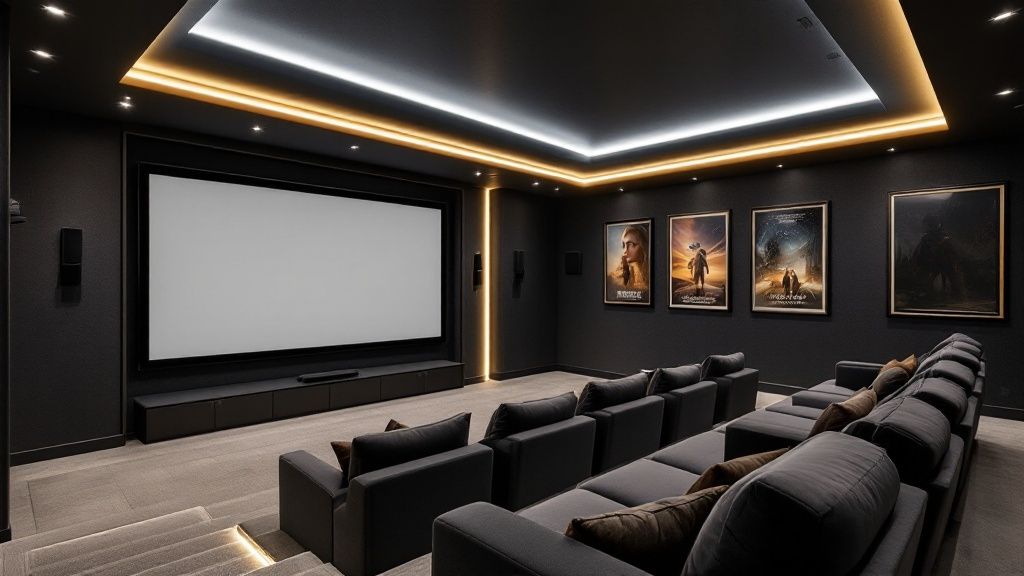A finished basement holds limitless potential, and one of the most exciting transformations is creating a dedicated home theater. More than just a big screen and some chairs, a well-designed basement cinema becomes a sanctuary for family movie nights, an immersive gaming hub, or the go-to spot for watching the big game. However, turning a blank subterranean space into a cinematic masterpiece requires careful planning around unique challenges like low ceilings, limited natural light, and acoustic complexities.
This guide offers eight distinct home theater ideas for your basement, moving beyond generic advice to provide actionable insights for creating a space that is both functional and breathtaking. We'll explore everything from industrial chic aesthetics that embrace exposed ductwork to luxurious, themed environments that transport you to another era. Each idea provides a blueprint for tackling common basement issues while maximizing style and performance.
Discover how to strategically manage layout, seating, lighting, and sound to build the perfect retreat right below your main living area. Whether you envision a cozy family den or a high-tech gaming command center, you'll find the practical steps needed to turn your specific entertainment dreams into a stunning reality.
1. Industrial Chic Cinema with Exposed Elements
Instead of spending a fortune to cover up your basement’s raw structural features, embrace them. The industrial chic cinema is one of the most authentic and stylish home theater ideas basement owners can implement, turning exposed brick, concrete floors, and visible ductwork into deliberate design choices. This aesthetic channels the vibe of a sophisticated urban loft or a converted warehouse, creating a viewing space that is both edgy and comfortable. It's a perfect match for basements where completely finishing the space might be impractical or cost-prohibitive.
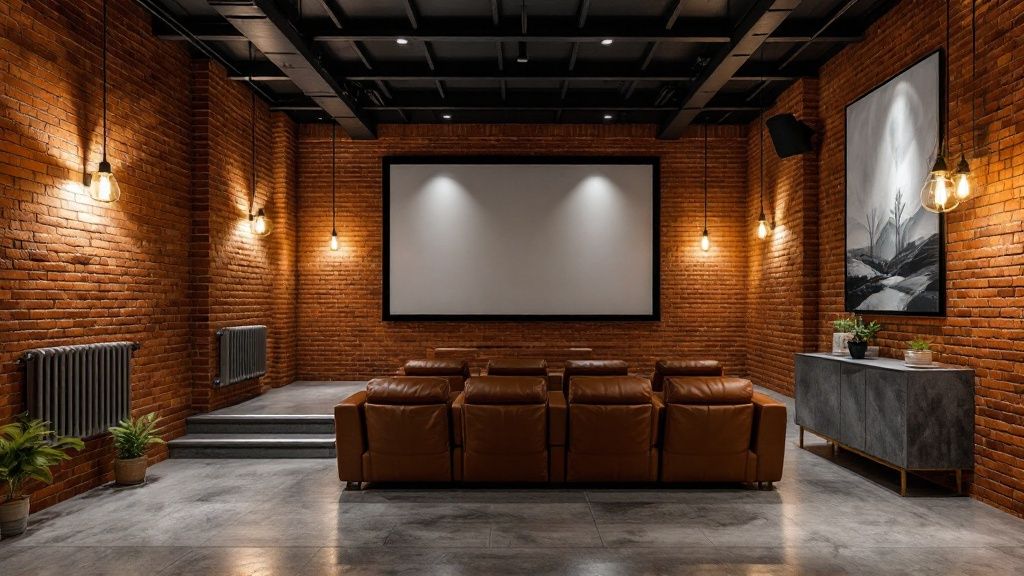
This design finds beauty in imperfection, pairing raw materials with modern technology. The contrast between a rough brick wall and a sleek, high-definition projector screen, or between polished concrete floors and plush leather seating, creates a dynamic and visually interesting environment. The key is to make these industrial elements look intentional, not neglected.
Key Implementation Strategies
To achieve this look without sacrificing cinematic quality, focus on balancing hard and soft textures while controlling light and sound.
- Soften Hard Surfaces: Industrial materials like concrete and brick are highly reflective of sound, which can create unwanted echo. Mitigate this by strategically placing soft, absorbent materials. Large, plush area rugs can define seating zones and dampen floor reverberations. You can also mount acoustic panels wrapped in fabric or disguised as modern art on walls to absorb sound without compromising the aesthetic.
- Warm Up the Lighting: Industrial spaces can feel cold. Counter this by installing a layered lighting scheme with warm-toned bulbs (around 2700K). Use dimmable track lighting to highlight architectural features like steel beams or brick walls, and add sconces or floor lamps to create a cozy, inviting glow.
- Integrate Décor Thoughtfully: Reinforce the theme with curated décor. Frame vintage movie posters in simple black or metallic frames. Use furniture with clean lines and materials like leather, reclaimed wood, and dark metal. This blend of old and new completes the sophisticated, lived-in feel.
2. Multi-Level Stadium Seating with Raised Platforms
To capture the true essence of a commercial cinema, nothing beats a tiered seating arrangement. Multi-level stadium seating is one of the most impactful home theater ideas basement owners can adopt, using raised platforms or built-in risers to ensure every viewer enjoys a perfect, unobstructed sightline to the screen. This approach elevates a simple media room into an authentic theatrical experience, making it ideal for families and homeowners who love to host movie nights.
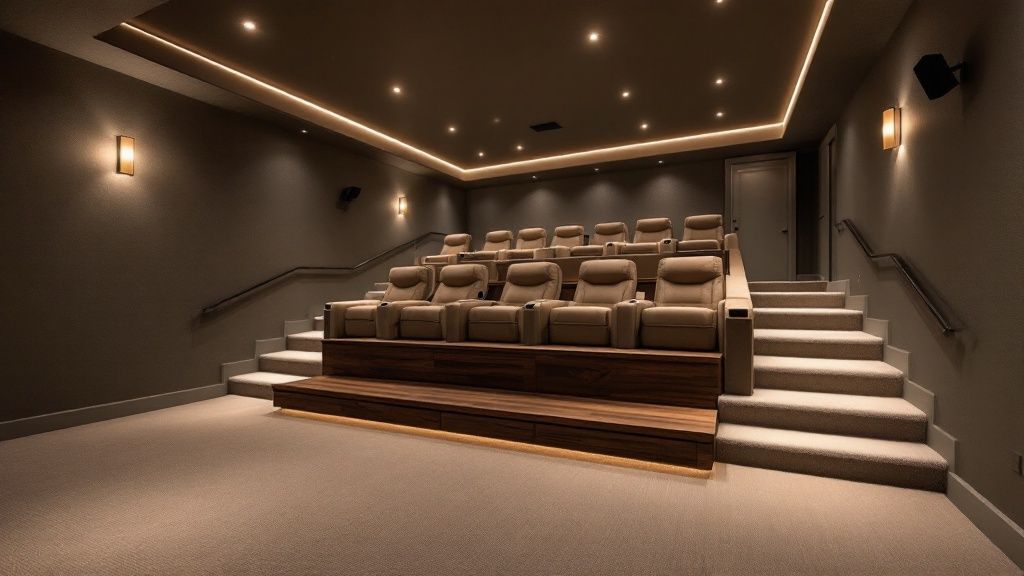
This design is more than just practical; it creates a dedicated and immersive viewing environment. By assigning each row its own elevation, you eliminate the common problem of heads blocking the screen and allow for more comfortable, spacious seating arrangements like plush recliners or couches. This structured layout is particularly effective in long, rectangular basements where a single row of seating would feel distant and disconnected.
Key Implementation Strategies
Successfully constructing a tiered theater requires careful planning around ergonomics, safety, and acoustics to maximize both comfort and performance.
- Calculate Riser Height Carefully: The goal is an unobstructed view. A general rule is to ensure a minimum rise of 12 inches between each platform. This height allows someone in a back row to comfortably see over the head of the person in front of them. The exact height will depend on your screen size, screen height from the floor, and seating distance.
- Prioritize Safety and Acoustics: With multiple levels comes the need for safe navigation in low light. Install low-voltage LED strip lighting along the edge of each step to prevent trips and add a professional, ambient glow. To prevent distracting vibrations, build the platforms as solid structures and consider adding high-density foam or rubber padding underneath the framework. For more in-depth guidance on structural considerations, you can explore various basement design ideas on buildnp.com.
- Choose the Right Seating: The type of seating you choose will influence the platform depth. Standard home theater recliners require significant depth to fully recline without hitting the row behind. Measure your chosen seats in their fully reclined position before finalizing the platform dimensions to ensure ample space for movement and comfort.
3. Retro Drive-In Theater Basement Design
Transform your basement into a nostalgic portal to the past with a retro drive-in theater theme. This creative concept recreates the magic of watching movies under the stars from the comfort of your own home, making it one of the most immersive and fun home theater ideas basement owners can choose. By incorporating elements like vintage car seating, a classic concession stand, and 1950s-inspired decor, you create not just a viewing room, but an unforgettable entertainment destination perfect for family movie nights and themed parties.
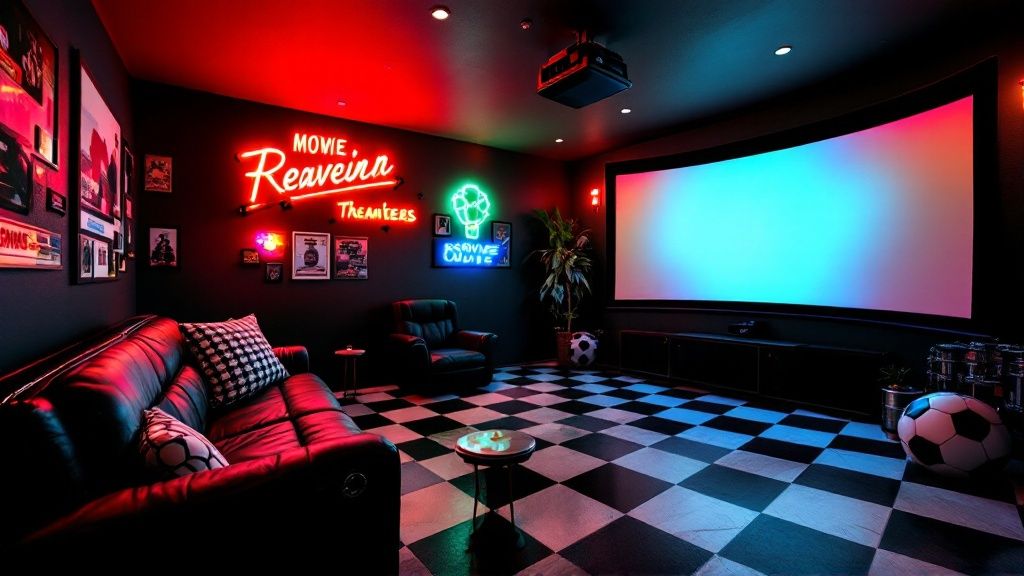
The charm of this design lies in its commitment to a whimsical, detailed theme. Imagine settling into a custom-built seating area resembling the back of a classic Chevrolet Bel Air while watching a blockbuster on a large projector screen. This approach is less about perfect acoustics and more about creating a unique, transportive experience that delights guests of all ages.
Key Implementation Strategies
To successfully capture the drive-in aesthetic, focus on iconic visual elements and ambient details that sell the illusion.
- Create Authentic Seating: The seating is the centerpiece of this theme. Source authentic car bench seats from an auto salvage yard for a genuine feel. Alternatively, build custom seating enclosures that mimic the look of classic convertibles. This not only enhances the theme but also provides comfortable, multi-person viewing spots.
- Design a Concession Stand: Dedicate a corner of the basement to a retro-style concession stand. Use a classic red-and-white color scheme, install a vintage-style popcorn machine, and add a mini-fridge for sodas in glass bottles. Displaying candy in glass jars and using a letter board for a "menu" completes the look.
- Set the Mood with Lighting and Decor: Ambiance is crucial. Install dimmable, neon-style LED strips along the walls or ceiling to mimic the glow of a drive-in. Paint a night-sky mural on the ceiling with glow-in-the-dark stars. Use removable vinyl wall decals of classic cars or 1950s movie icons to add detail without permanent changes.
4. Luxury Wine Cellar Theater Combination
For homeowners who appreciate both fine wine and fine cinema, merging these two passions creates an exceptionally sophisticated entertainment space. The luxury wine cellar theater is one of the most elegant home theater ideas basement owners can explore, transforming a functional cellar into a lavish, dual-purpose destination. This concept pairs the climate-controlled precision of a wine collection with the immersive experience of a high-end theater, perfect for hosting tasting events or enjoying a film with a favorite vintage.
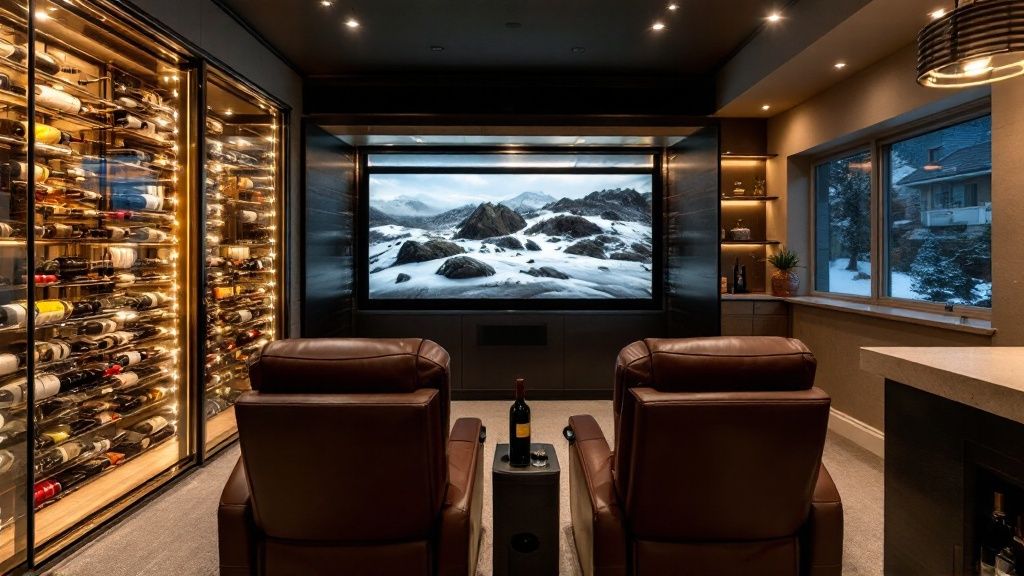
This design is the epitome of adult-focused luxury, turning an ordinary basement into an exclusive retreat. The ambiance is set by rows of beautifully displayed wine bottles, which serve as a stunning backdrop for plush theater seating and state-of-the-art audiovisual equipment. It’s a design seen in high-end custom homes and celebrity showcases, offering an unparalleled level of class and utility for the discerning homeowner.
Key Implementation Strategies
Success lies in creating two distinct, yet harmonious, environments that do not compromise the integrity of either the wine or the viewing experience.
- Implement Zoned Climate Control: Wine requires a specific environment (typically 55°F with controlled humidity) that is too cold for comfortable viewing. Install a dual-zone HVAC system to maintain the cellar's precise climate while keeping the theater seating area at a comfortable temperature. Use insulated, UV-resistant glass walls or doors to separate the two spaces physically while maintaining a seamless visual connection.
- Manage Light and Reflections: Dark, rich materials are your ally. Use dark wood for wine racks, deep paint colors like charcoal or burgundy on walls, and non-reflective finishes to prevent light from the screen from bouncing off glass bottles and creating distractions. Low-voltage, directional accent lighting can highlight the wine collection without interfering with the movie.
- Integrate Seating and Layout: Arrange seating so that the wine collection serves as a dramatic and beautiful background. Consider tiered leather recliners or a large, comfortable sectional facing the screen. You can also incorporate a small bar or tasting table at the back of the room for a multi-functional entertainment hub.
5. Gaming and Theater Hybrid Space
For the modern family that loves both cinematic blockbusters and immersive video games, a dedicated movie-only room isn't always practical. The gaming and theater hybrid is one of the most versatile home theater ideas basement dwellers can adopt, creating a multi-functional entertainment hub that caters to everyone. This concept blends the high-fidelity audio and video of a traditional theater with the interactive needs of a serious gaming setup, ensuring the space is always in use.
This design moves beyond a simple "TV with a console" by integrating systems for a seamless experience. It acknowledges that gaming audio and visuals have reached cinematic quality, demanding similar attention to acoustics, lighting, and seating. The result is a flexible environment that can transform from a family movie night venue into a competitive esports arena or an adventurous RPG session with minimal effort.
Key Implementation Strategies
Successfully merging these two distinct activities requires thoughtful planning around technology, acoustics, and organization.
- Plan for High-Power Tech: Gaming PCs and consoles draw significant power, and when combined with a powerful AV receiver and projector, they can overload a standard circuit. Install dedicated electrical circuits for your high-demand equipment to prevent tripped breakers and ensure stable performance during intense gameplay or action-packed movie scenes.
- Optimize for Dynamic Audio: The soundscapes of video games are often more dynamic and complex than movie soundtracks. Use acoustic panels and bass traps designed to handle a wide, dynamic audio range. This prevents muddy bass and ensures that both explosive in-game effects and subtle dialogue are crystal clear. Proper speaker placement for surround sound is crucial for both immersive gaming and cinematic audio.
- Create Smart Storage Zones: Keep the space tidy and functional with designated storage. Use cabinets or wall-mounted shelving to organize controllers, headsets, games, and movie discs. This prevents clutter and makes it easy to switch between activities, maintaining a clean aesthetic for your hybrid entertainment room.
6. Sports Bar Theme with Multiple Screens
Transform your basement into the ultimate game-day destination by creating a sports bar-themed home theater. This idea moves beyond a single large screen, embracing a multi-display setup that captures the exciting, dynamic atmosphere of a real sports bar. It’s one of the best home theater ideas basement dwellers can adopt to host unforgettable viewing parties, allowing guests to follow multiple games, track fantasy stats, and never miss a single play. This design is perfect for the avid sports fan who wants a dedicated, high-energy space for entertainment.
The core of this concept is simultaneous viewing. A large central projector screen or TV can feature the main event, while smaller, flanking screens display other games or sports news tickers. Paired with bar-style seating, authentic memorabilia, and a fully stocked wet bar, this setup creates an immersive and social environment that feels like a private, upscale sports lounge.
Key Implementation Strategies
To successfully build your basement sports bar, focus on strategic screen placement, functional seating, and authentic atmospheric details.
- Create Viewing Zones: Plan your screen layout to allow for simultaneous, unobstructed viewing. A "video wall" with one large central display and two or four smaller ones is a popular configuration. Ensure your AV system can route different sources to each screen independently. Consider adding a small TV in the bar or kitchenette area so no one misses a moment while grabbing a drink. If you're planning a full bar setup, you can explore some basement bar and kitchenette ideas for inspiration.
- Incorporate Bar-Style Seating: Ditch the traditional theater recliners for a more social arrangement. Use high-top tables with bar stools, comfortable booths along a wall, and a long bar with seating. This encourages conversation and movement, mimicking the lively vibe of a real sports bar. Use durable, easy-to-clean materials like commercial-grade vinyl or leather.
- Control the Sound: With multiple audio sources and excited fans, a sports bar theater can get loud. Install sound-dampening materials like acoustic wall panels, thick carpeting, and solid-core doors to contain noise and prevent it from traveling to the rest of the house. This ensures an energetic atmosphere without disturbing others.
7. Cozy Family Den with Sectional Seating
Not all home theaters need to be formal, dedicated cinemas. The cozy family den approach transforms your basement into a warm, inviting multi-purpose space centered around comfort and togetherness. This is one of the most practical home theater ideas basement dwellers can adopt, prioritizing large sectional sofas, soft lighting, and casual décor to create a relaxed environment perfect for family movie nights, binge-watching shows, or even just lounging. It’s an ideal solution for families who want a media space that feels integrated with their daily life, not separate from it.
This design philosophy moves away from rigid, tiered theater seating in favor of a large, plush sectional that encourages cuddling up and relaxing. The goal is to create a room that is as good for conversation and board games as it is for watching the latest blockbuster. The focus is less on replicating a commercial cinema and more on enhancing the everyday family experience with high-quality audio and video.
Key Implementation Strategies
To successfully create a cozy den atmosphere that still delivers an excellent media experience, focus on flexible seating, forgiving materials, and adaptable lighting.
- Prioritize a Large Sectional: The cornerstone of this design is a deep, comfortable sectional sofa. Position it at the optimal viewing distance from your screen for an immersive experience. Look for modular sectionals that can be reconfigured and choose durable, stain-resistant fabrics to handle spills and daily wear from kids and pets.
- Layer with Flexible Furnishings: Augment your sectional with versatile pieces. Large ottomans can serve as footrests, extra seating, or even a makeshift table with a tray. Beanbags and floor pillows offer casual seating options for kids, making the space adaptable for larger gatherings.
- Install Dimmable, Warm Lighting: Create a welcoming ambiance with a layered lighting scheme. Use dimmable recessed lights for overall illumination and supplement with floor lamps and table lamps to create cozy corners. A warm color temperature (around 2700K) makes the space feel inviting, even when the main screen is off. Learn more about finishing a basement on a budget to see how lighting and furnishings can transform a space affordably.
8. Art Deco Theater with Vintage Hollywood Glamour
Transform your lower level into a classic 1930s movie palace by embracing the opulence of Art Deco design. This style is one of the most elegant and immersive home theater ideas basement owners can choose, creating a space that feels like a true escape into the golden age of Hollywood. Characterized by rich colors, bold geometric patterns, and luxurious materials like velvet and brass, an Art Deco theater evokes a sense of grandeur and occasion every time you sit down to watch a film.
This aesthetic is all about creating a complete, transportive experience. It moves beyond just a screen and speakers to build an entire environment dedicated to the magic of cinema. From stepped ceilings and vertical lines to symmetrical layouts and lavish details, every element works together to capture the glamour of a historic picture house, making your basement feel less like a part of your home and more like a private, exclusive venue.
Key Implementation Strategies
Achieving an authentic Art Deco feel requires a commitment to specific materials, patterns, and a carefully planned lighting scheme.
- Embrace Symmetrical and Geometric Forms: Art Deco is defined by symmetry and repeating patterns. Incorporate this through architectural details like tiered ceiling soffits (tray ceilings), decorative wall moldings in sunburst or chevron patterns, and symmetrical furniture arrangements. This creates a sense of order and grandeur fundamental to the style.
- Utilize Rich Materials and Colors: Build a luxurious palette with deep jewel tones like emerald green, sapphire blue, or ruby red, contrasted with black, gold, or chrome accents. Use plush velvet for seating and curtains, and consider high-gloss lacquer finishes for cabinetry. These materials not only look opulent but also have excellent acoustic properties, absorbing sound to reduce echo.
- Layer Moody, Theatrical Lighting: Lighting is critical for setting the mood. Install classic Art Deco wall sconces with frosted or geometric glass shades to provide ambient light. Use recessed lighting in ceiling soffits to create a soft, indirect glow, and ensure all lights are on dimmers to transition seamlessly from mingling to movie-watching.
Basement Home Theater Style Comparison
| Industrial Chic Cinema | Moderate | Utilizes existing structures, some acoustic treatment | Sophisticated, edgy urban aesthetic with durable materials | Modern urban basements, loft conversions | Cost-effective, unique look, easy maintenance |
| Multi-Level Stadium Seating | High | Higher construction cost, requires structural changes | Optimal sightlines and increased seating capacity | Luxury homes, large basements | Authentic theater feel, built-in storage |
| Retro Drive-In Theater | Moderate | Custom fabrication, vintage decor sourcing | Highly thematic and nostalgic atmosphere | Vintage-themed entertainment spaces | Unique design, multi-generational appeal |
| Luxury Wine Cellar Theater Combo | High | Specialized climate control systems and premium finishes | Upscale dual-use space combining entertainment and wine storage | High-end basements, wine country homes | Adds home value, sophisticated ambiance |
| Gaming and Theater Hybrid Space | High | Complex technical setup, multiple systems | Versatile, tech-forward entertainment environment | Family homes with mixed media interests | Future-proof, multi-function utility |
| Sports Bar Theme | Moderate to High | Multiple screens, commercial-grade installations | Energetic social atmosphere for sports viewing | Sports enthusiasts, large group events | Large capacity, easy cleanup, party-friendly |
| Cozy Family Den | Low | Basic furniture and soft lighting | Comfortable, casual family-friendly environment | Families seeking relaxed movie nights | Cost-effective, very comfortable |
| Art Deco Theater | High | Expensive materials, detailed finishes | Luxurious, glamorous vintage cinema experience | Historic homes, formal entertainment | Timeless elegance, impressive guest experience |
Bringing Your Vision to Life with Professional Expertise
Your journey from a bare concrete space to an immersive cinematic escape is filled with exciting possibilities. We have explored a diverse range of home theater ideas basement designs, each offering a unique way to transform your lower level. From the raw, urban appeal of an Industrial Chic cinema with exposed ductwork to the sophisticated glamour of an Art Deco theater, the potential is limited only by your imagination.
We've seen how practical solutions, like multi-level stadium seating, can guarantee a perfect view for everyone, and how a cozy family den can blend everyday comfort with cinematic magic. Whether you envision a high-energy gaming hybrid space, a sports bar theme with multiple screens for game day, or the unique elegance of a wine cellar theater combination, the core principles remain the same. A truly exceptional home theater is a masterful blend of aesthetics, functionality, and technical precision.
From Inspiration to Implementation
The most crucial takeaway is that a successful project goes far beyond choosing a theme. It requires careful consideration of several key elements that work in harmony:
- Acoustic Management: Properly treating walls and ceilings to absorb sound is non-negotiable for achieving clear dialogue and impactful sound effects without echo.
- Strategic Lighting: A layered lighting plan, incorporating dimmable sconces, recessed lights, and accent LEDs, sets the mood and enhances the viewing experience.
- Optimized Layout: The placement of your screen, speakers, and seating is critical for creating an immersive audio-visual environment.
- Comfort and Style: Seating choices, color palettes, and decor are what personalize the space and make it a truly inviting retreat for family and friends.
Mastering these concepts is what elevates a simple room with a big screen into a genuine home cinema. It’s an investment not just in your property's value but in creating a dedicated sanctuary for entertainment, relaxation, and making lasting memories. The difference between a good and a great basement theater lies in the meticulous execution of these details, ensuring every component supports the overall vision.
Your Next Steps to the Ultimate Home Theater
Transforming these inspiring home theater ideas basement concepts into a tangible, high-quality reality involves navigating complex structural, electrical, and code-related challenges. While the design phase is exciting, the construction phase demands expertise to ensure your investment is safe, durable, and flawlessly executed. This is where professional guidance becomes invaluable. For homeowners in Orem, Provo, and the greater Utah area, partnering with a specialist ensures that everything from custom platform construction to intricate wiring is handled with precision. By combining your unique vision with seasoned craftsmanship, you can confidently build the immersive entertainment hub you’ve always dreamed of.
Ready to turn your basement into the ultimate cinematic experience? The expert team at Northpoint Construction specializes in custom basement finishing and can bring even the most ambitious home theater designs to life. Contact us today to start planning your project at Northpoint Construction.

